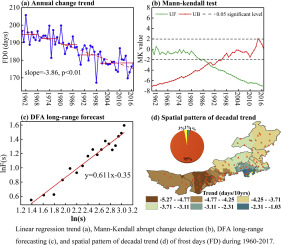Science of the Total Environment ( IF 8.2 ) Pub Date : 2018-08-21 , DOI: 10.1016/j.scitotenv.2018.08.262 Siqin Tong , Xiangqian Li , Jiquan Zhang , Yuhai Bao , Yongbin Bao , Li Na , Alu Si

|
Due to global warming, extreme climate events have become an important issue, and different geographical regions have different sensitivities to climate change. Therefore, temporal and spatial variations in extreme temperature and precipitation events in Inner Mongolia were analyzed based on the daily maximum temperature, minimum temperature, and precipitation data during the period of 1960–2017. The results showed that warm extreme indices, such as SU25, TX90p, TN90p, and WSDI, significantly increased, whereas the cold extreme indices, such as FD0, TX10p, TN10p, and CSDI, significantly decreased; all indices have obvious abrupt changes based on the Mann-Kendall test; nighttime warming was higher than daytime warming. Extreme precipitation indices slightly decreased overall. All of the extreme temperature and precipitation indices had long-range correlations based on detrended fluctuation analysis (a > 0.5), thereby indicating that the extreme climate indices will maintain their current trend directions in the future. ENSO, AO, and IOD had a strong positive influence on warm extremes and a strong negative influence on cold extremes in Inner Mongolia. NCEP/NCAR and ERA-20CM reanalysis showed that strengthening anticyclone circulation, increasing geopotential height, decreasing daytime cloudiness and increasing nightime cloudiness contributed to changes in climate extremes in Inner Mongolia.











































 京公网安备 11010802027423号
京公网安备 11010802027423号